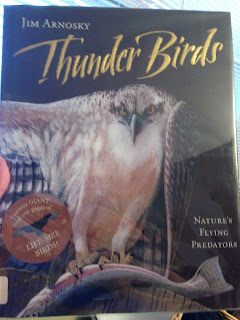Thunder Birds by Jim Arnosky is an interesting look at nature's flying predators. Jim Arnosky is a noted author of natural topics, with many titles geared toward children.
In Thunder Birds, Arnosky uses a familiar tone with the reader, often using first person and sharing his experiences learning about these birds. The books says it features giant, life size, fold out pages. while the pages folding out is a great addition and the pages mention the sizes of the birds and what is actual size, it could be a little hard to follow for some. Arnosky paints the pages, with great detail. He also brings us back to the dinosaur connection with birds, imagining these flying creatures connected to the dinosaurs of the past. Additionally, he uses the title Thunder Birds to remind us of a "giant, eagle like Native American spirit that brought the thunder and lightning." The birds chosen are similar to this Thunder Bird.
Arnosky uses the following categories:
Eagles, Hawks, and Falcons
Owls (loved the barred and barn owls below)
Vultures
Herons and Egrets
Pelicans
Detailed drawings help us understand the heads, bills, and feet in more depth.
Of course, we had to test out our arm span compared to an osprey's wingspan. It helped us to put some of it into perspective based on the various boys' heights. I made some wingspan silhouettes with a colleague after going to the Flying Wild training. It's a great training if you're interested in teaching about birds.
Arnosky makes these birds come to life. His descriptions are refreshing. He mentions, "Birds know a freedom of movement and space that we can only imagine. They have a limitless sky in which to fly and the whole world to come down to. Up high, they can see the patchwork of the landscape, the expanse of the sea, and the broad curve of the horizon. They climb on air and ride the wind. They hover, flap, glide, and soar." I have seen many of the birds in the book do these same things, most recently watching a bald eagle up close and a turkey vulture glide for miles with a slight turn of the wings.
The book includes a contents page at the beginning, alerting us to the fold out pages. The author's note at the end, talk about how he does the paintings and places he went to research these birds. It's nice that we've been to a few places, like Chincoteague, Okefenokee, Everglades, etc. There is also a list of books to learn about birds and a scale for metric equivalents.
Turkey vultures are mentioned in the book. I also like the book, Vulture View, for younger audiences. It simply shares information about vultures in an easy manner. See my review here.
Interested in birds?
Here are a few related posts:
Birds in Spring--Nature Preschool


